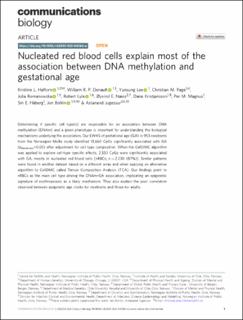| dc.contributor.author | Haftorn, Kristine Løkås | |
| dc.contributor.author | Denault, William Robert Paul | |
| dc.contributor.author | Lee, Yunsung | |
| dc.contributor.author | Page, Christian Magnus | |
| dc.contributor.author | Romanowska, Julia | |
| dc.contributor.author | Lyle, Robert | |
| dc.contributor.author | Næss, Øyvind Erik | |
| dc.contributor.author | Kristjansson, Dana | |
| dc.contributor.author | Magnus, Per Minor | |
| dc.contributor.author | Håberg, Siri Eldevik | |
| dc.contributor.author | Bohlin, Jon | |
| dc.contributor.author | Jugessur, Astanand | |
| dc.date.accessioned | 2024-01-02T07:20:43Z | |
| dc.date.available | 2024-01-02T07:20:43Z | |
| dc.date.created | 2023-03-02T14:01:43Z | |
| dc.date.issued | 2023 | |
| dc.identifier.citation | Communications Biology. 2023, 6:224 1-11. | |
| dc.identifier.issn | 2399-3642 | |
| dc.identifier.uri | https://hdl.handle.net/11250/3109213 | |
| dc.description.abstract | Determining if specific cell type(s) are responsible for an association between DNA methylation (DNAm) and a given phenotype is important for understanding the biological mechanisms underlying the association. Our EWAS of gestational age (GA) in 953 newborns from the Norwegian MoBa study identified 13,660 CpGs significantly associated with GA (pBonferroni | |
| dc.description.abstract | Nucleated red blood cells explain most of the association between DNA methylation and gestational age | |
| dc.language.iso | eng | |
| dc.title | Nucleated red blood cells explain most of the association between DNA methylation and gestational age | |
| dc.title.alternative | Nucleated red blood cells explain most of the association between DNA methylation and gestational age | |
| dc.type | Peer reviewed | |
| dc.type | Journal article | |
| dc.description.version | publishedVersion | |
| dc.source.pagenumber | 1-11 | |
| dc.source.volume | 6:224 | |
| dc.source.journal | Communications Biology | |
| dc.identifier.doi | 10.1038/s42003-023-04584-w | |
| dc.identifier.cristin | 2130785 | |
| dc.relation.project | Norges forskningsråd: 262700 | |
| cristin.ispublished | true | |
| cristin.fulltext | original | |
| cristin.qualitycode | 1 | |
